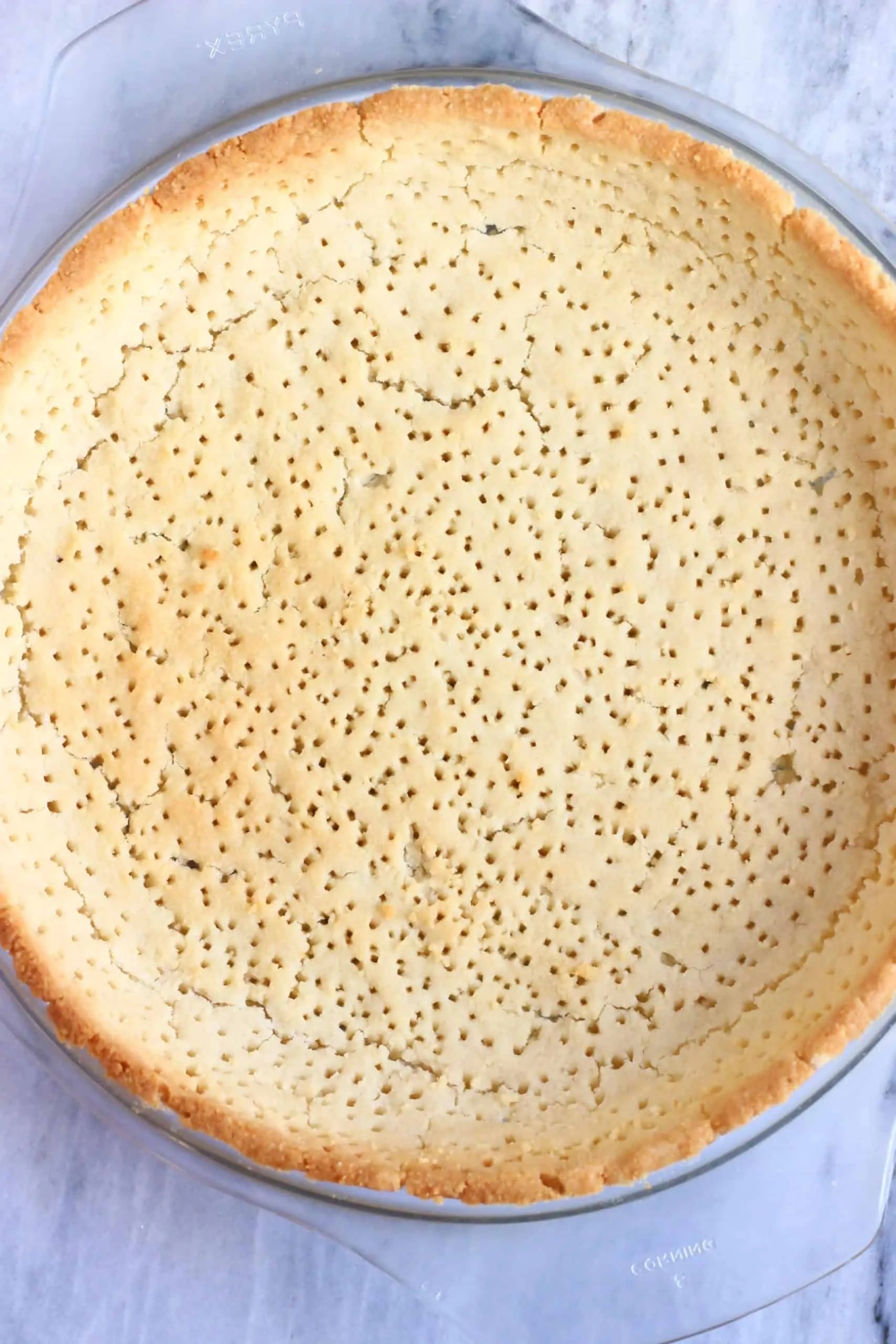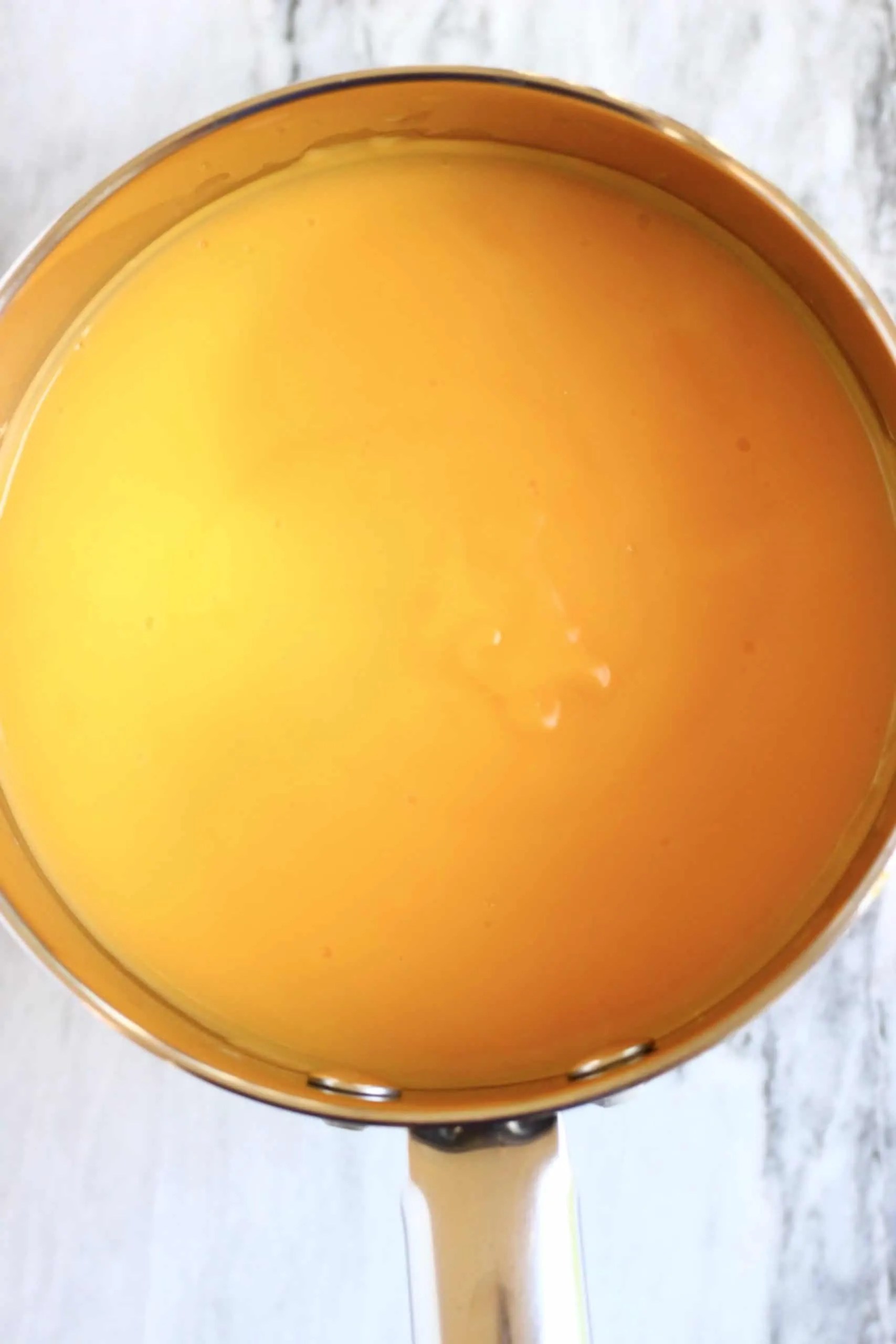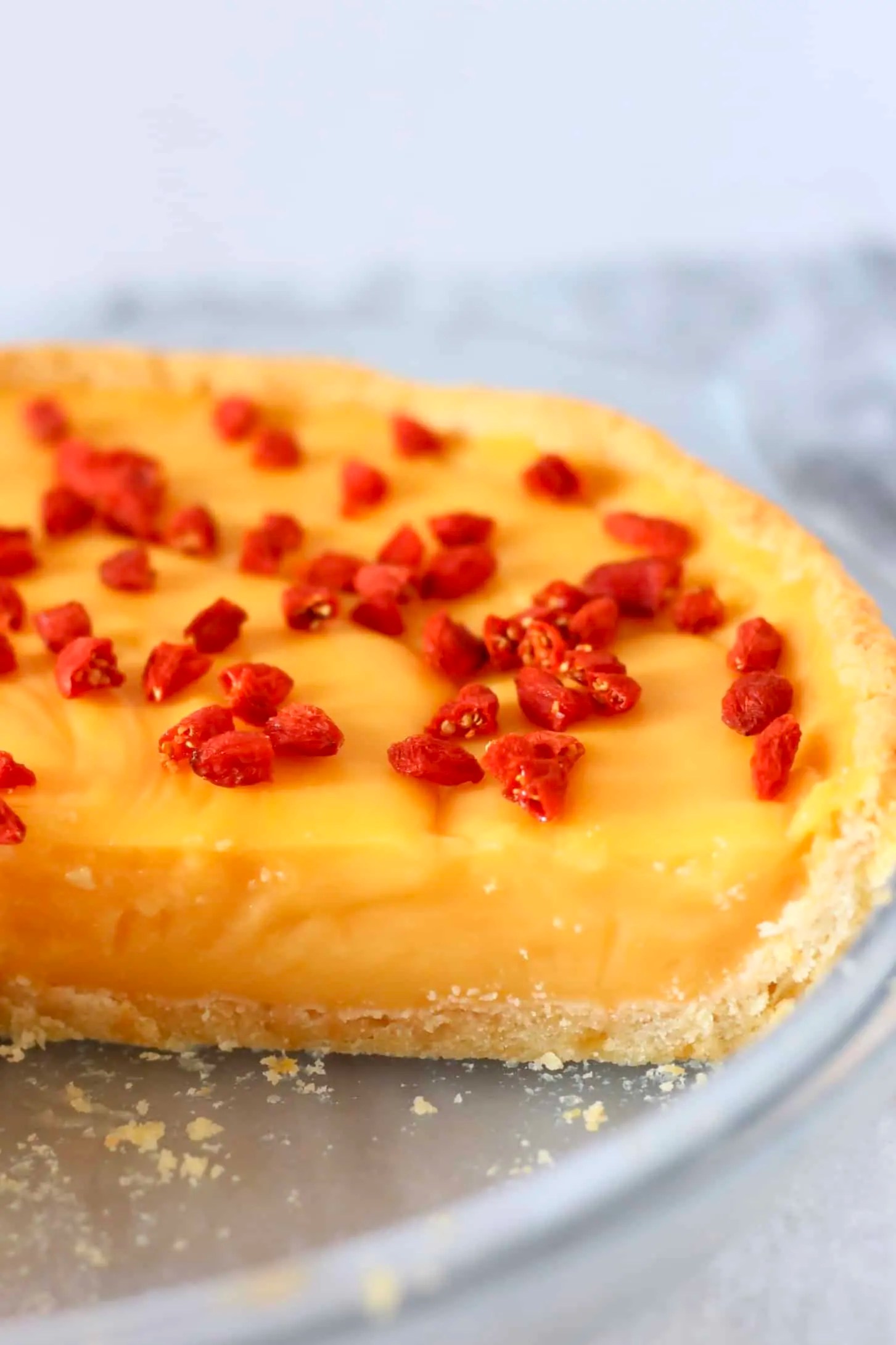Last updated - ; Published - By Rhian Williams 19 Comments
Jump to Recipe Jump to Video Print Recipe
This Gluten-Free Vegan Lemon Tart has a "buttery", flakycrust and acreamy, tangy lemon custard filling. It's fragrant and fruity, rich and creamy, and refined sugar free too. The perfect elegant dessert for Easter!

This tart is super easy to make as the pastry crust can be pressed in with your fingers, there's no need for a rolling pin or floured surface, you don't have to chill the pastry beforehand, and it doesn't require a blender or food processor!
How is the lemon custard made?
The lemon custard is made using shop-bought custard powder.
This is my favouritecustard powder - it's vegan, gluten-free and sugar-free, and contains just 4 simple ingredients!

Not only does this custard powder act as a thickener, making the lemon custard extra creamy, but it also adds a lovely colour without having to use something like turmeric.
What can the custard powder be replaced with?
If you can't get hold of a shop-bought custard powder, you can replace it with the same amount of cornflour (cornstarch) or arrowroot, which will result in a similar texture, though the colour will be considerably less yellow.
To add yellow colour, I would suggest adding a tiny pinch of saffron, which I much prefer to turmeric as it has a much milder flavour.
What type of plant-based milk is used to make the lemon custard?
You can use any type of plant-based milk, though results do vary depending on which one you choose. I like to use unsweetened cashew milk. Cashew, oat or coconut milk make a super thick and creamy custard, whilst almond milk will be less creamy. Rice milk creates a just-setlemon curd-like consistency.
How to make this recipe
Scroll down to the bottom ofthis post for the fullrecipe.
- Combine all ingredients for the pastry dough in aglass mixing bowl.
Tip: Add the water a few tablespoons at a time so that you don’t add too much!

- Place the pastry dough into a greasedpie dishand use your fingers to carefully press it across the bottom and up the sides of the dish.
- Use a fork to pierce holes in the surface of the pastry crust (this ensures the crust doesn't puff up when you bake it) - don't forget the sides too. You can alternatively use baking beans.

- Bake in the oven for30 minutesuntil golden brown.

- Measure out the rice milk in a measuring jug.
- Pour the milk into a pan, leaving behind a few tablespoons of milk in the jug.
- Heat up the milk.
- Add the custard powder to the remaining milk in the jug and mix well, ensuring it has dissolved completely.
- Once the milk in the pan is steaming, add approximately half of the hot milk to the bowl with the dissolved custard powder, mix well and transfer the custard powder mixture to the pan.
- Mix well and keep stirring on a low heat for around 5 minutes, until thickened.
- Add the lemon juice and maple syrup.
- Taste and adjust the amount of lemon juice and maple syrup, if desired.

- Once the tart crust has cooled a little, carefully pour the filling into the crust.

- Leave to cool completely before cutting, keeping the tart in the fridge for a few hours to allow the filling to set properly.

Substitutions you can make
- You can replace the gluten-free flourin the pastry crust with rice flour.
- You can replace the gluten-free flour with plain flour if you’re not gluten-free.
- You can use any type of liquid sweetener: maple syrup, agave syrup, brown rice syrup etc.
- The ground almonds (almond meal) can be replaced with ground walnuts.
- For a nut-free version, use ground sunflower seeds instead of ground almonds and use a nut-free milk.
Substitutions to be careful of
You can use any type of plant-based milk, though results do vary depending on which one you choose. I like to use unsweetened cashew milk. Cashew, oat or coconut milk make a super thick and creamy custard, whilst almond milk will be less creamy. Rice milk creates a just-setlemon curd-like consistency.

How long does this keep for?
This Lemon Tart keeps well in the fridgefor up to afew days.

More pie and tart recipes
- Fruit Tart
- Chocolate Tart
- Peach Pie
- Strawberry Pie
- Chocolate Pie
- Peanut Butter Pie
If you try out this recipe or anything else from my blog,I’d really love to hear anyfeedback! Please give it a rating, leave a comment, or tag a photo @rhiansrecipes #rhiansrecipes onInstagram! Thank you.
Watch how to make it

Gluten-Free Vegan Lemon Tart
This Gluten-Free Vegan Lemon Tart has a "buttery", flakycrust and acreamy, tangy lemon custard filling. The perfect elegant dessert!
4.84 from 6 votes
Print Pin Rate
Course: Dessert
Cuisine: French
Keyword: gluten-free lemon tart, gluten-free vegan pie, vegan lemon tart
Prep Time: 15 minutes minutes
Cook Time: 40 minutes minutes
Total Time: 55 minutes minutes
Servings: 8
Calories: 218kcal
Author: Rhian Williams
Ingredients
For the pastry:
- 30 g (⅛ cup) coconut oil
- 75 g (⅔ cup) gluten-free flour blend (or sub rice flour, or plain all-purpose flour if not gluten-free)
- 75 g (⅔ cup) ground almonds (almond meal) *
- 7 tablespoons water
For the lemon custard:
- 700 ml (3 cups) unsweetened cashew milk ** (see notes)
- 55 g (⅜ cup) custard powder *** (or sub cornflour/cornstarch or arrowroot)
- 16 tablespoons lemon juice
- 9 tablespoons maple syrup
Instructions
For the pastry:
Preheat the oven to 180 degrees Celsius (350 degrees Fahrenheit).
Combine all ingredients in a large bowl along with about 7 tablespoons of water, until it forms a firm dough - add the water a few tablespoons at a time so that you don’t add too much! You can keep this pastry dough in the fridge for up to a day if you like, but there is no need to chill it before using.
Place the pastry dough into a greased pie dish and use your fingers to carefully press it across the bottom and up the sides of the dish - I used a 22.5cm/9inch pie dish.
Use a fork to pierce the surface (remember the sides too!) of the pastry, so that it doesn’t puff up in the oven. Alternatively, you can use baking beans.
Bake in the oven for around 30 minutes, until the pastry crust is firm to the touch and golden brown.
Leave to cool slightly before pouring in the filling.
For the lemon custard:
Measure out the milk in a jug or measuring container.
Pour the milk into a pan, leaving behind a few tablespoons of milk in the jug.
Heat up the milk in the pan.
Add the custard powder to the remaining milk in the jug and mix well, ensuring it has dissolved completely.
Once the milk in the pan is steaming, add approximately half of the hot milk to the bowl with the dissolved custard powder, mix well and transfer the custard powder mixture to the pan.
Mix well and keep stirring on a low heat for around 5 minutes, until thickened.
Add the lemon juice and maple syrup.
Taste and add extra lemon juice or maple syrup if desired.
To assemble:
Once the tart crust has cooled a little, carefully pour the filling into the crust.
Leave to cool completely before cutting, keeping the tart in the fridge for few hours to allow the filling to set properly.
Keeps covered in the fridge for up to a few days.
Video
Notes
*You can alternatively use almond flour.
**You can use any type of plant-based milk, though results do vary depending on which one you choose. I like to use unsweetened cashew milk. Cashew, oat or coconut milk make a super thick and creamy custard, whilst almond milk will be less creamy. Rice milk creates a just-setlemon curd-like consistency.
***If you can’t get hold of a shop-bought custard powder, you can replace it with the same amount cornflour (cornstarch) or arrowroot, which will result in the same texture, though the colour will be considerably less yellow. To add yellow colour, I would suggest adding a tiny pinch of saffron, which I much prefer to turmeric as it has a much milder flavour.
Nutrition Facts
Gluten-Free Vegan Lemon Tart
Amount Per Serving
Calories 218Calories from Fat 90
% Daily Value*
Fat 10g15%
Saturated Fat 4g20%
Cholesterol 18mg6%
Sodium 82mg3%
Potassium 119mg3%
Carbohydrates 31g10%
Fiber 2g8%
Sugar 15g17%
Protein 3g6%
Vitamin A 15IU0%
Vitamin C 12mg15%
Calcium 67mg7%
Iron 1mg6%
* Percent Daily Values are based on a 2000 calorie diet.
Made the recipe?Tag @rhiansrecipes on instagram and use the hashtag #rhiansrecipes!
Disclosure: This posts contains affiliate links to Amazon. If you purchase any of these products, a small percentage will come to me with no extra cost to you! This income will go towards the running of this blog – thank you.